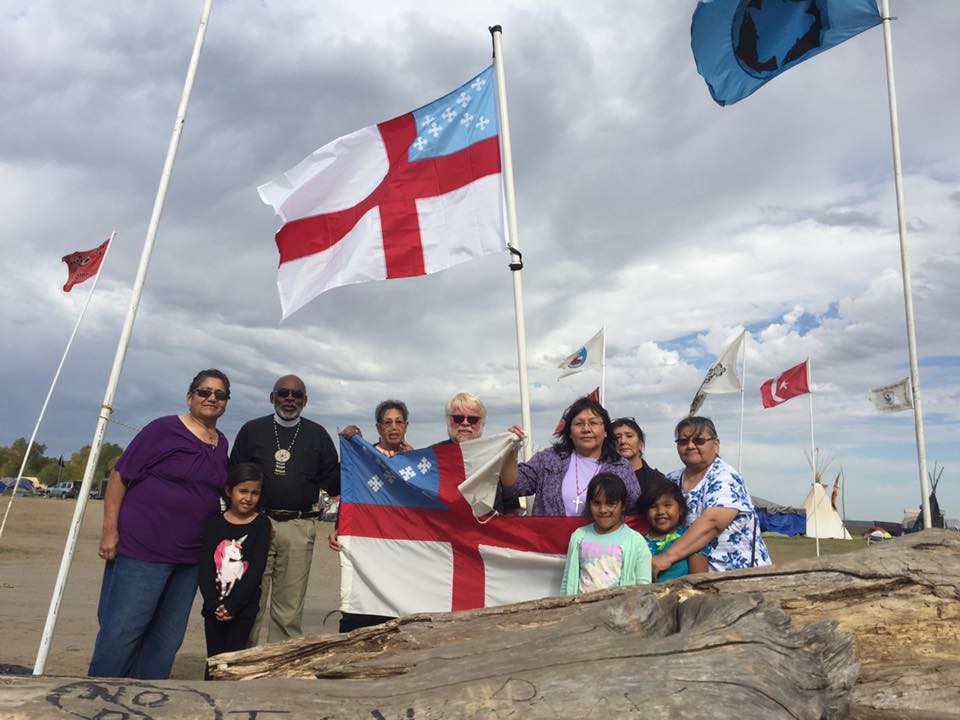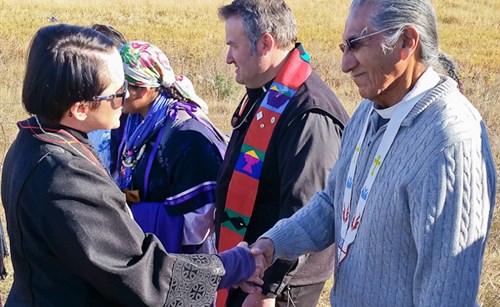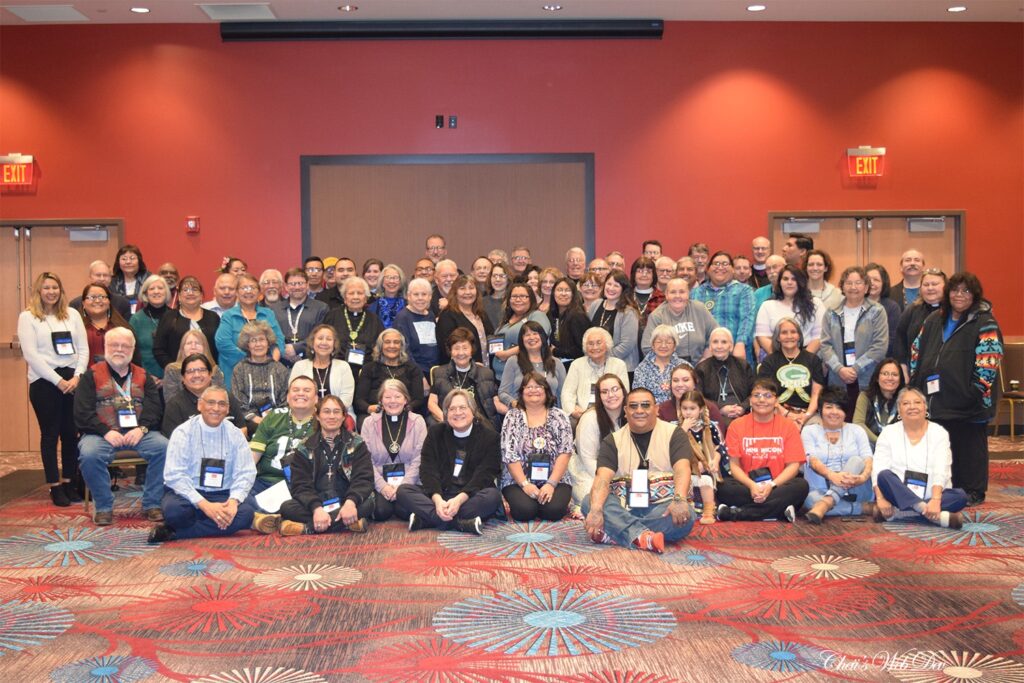Welcome to the Land Acknowledgement page of the Diocese of Olympia.
Land Acknowledgement
An overt action by one group of peoples to acknowledge the land they are situated on used to belong to another group of peoples and quite possibly was acquired through actions typical of one dominant culture expressing influence over another, through economic oppression, coercion, thievery, treaty violations, violent actions, or other subversive acts.
This page originates from Resolution #5, which was passed during the Diocesan Convention of November 2019 with the intent of creating a committee to address the issue of Land Acknowledgement for the Diocese of Olympia. (The full text of the resolution can be found below.)
Resolution #5 goals are to:
- Create a committee on Land Acknowledgement, and
- Develop policies for land acknowledgement. (For specifics about suggested policies, click here.)
Two things are presented in this document:
- The committee’s work to compile resources, including interactive maps, historical information, and videos, on the Doctrine of Discovery from the Indigenous Ministries of the Episcopal Church, and
- a few suggested “how to’s” for a church or parish to use getting started.
This can be an exciting and rewarding journey for congregations and individuals. Though it begins as an effort to understand the history of an individual church, it can soon develop into exploration of the history of our entire country and even the world. All are connected, for good or ill, in the story of who we are as a people, as a nation, as Episcopalians, and as Christians.
As Christians it is our obligation to see the “other” as children of God in one human family; to treat every person with genuine love and to honor the dignity all people. Every encounter with every person is a sacred encounter because every person is a sacred vessel of the Holy. “What you did for the least of these, you did for me” (Matthew 25:40). Enjoy the journey, for you will be blessed.

The Stance of the Episcopal Church
The Indigenous Ministries of The Episcopal Church “works for full inclusion of Native Peoples in the life and leadership of the Church. This is a goal we share with you. In order to reach this goal, we welcome you as our partner to:
- guarantee that Native Peoples are fully recognized and welcomed into congregational life through education of congregations, advocacy for Native Peoples, and leadership development of Native Peoples,
- create influential leadership roles in the church for Native Peoples,
- develop a national support system for continued remembrance, recognition, and reconciliation with and among all Native Peoples,
- develop a network of leadership and educational resources to empower Native Peoples to prepare for mission and ministry in the Episcopal Church, and
- provide resources, advocacy, and support to indigenous theology students who are Native Peoples.”
The Doctrine of Discovery has its roots in papal bulls of the 15th century, which gave Christian explorers the right to claim lands they “discovered” and to declare these to be subject territories for their Christian monarchs. Any land that was not inhabited by Christians was available to be “discovered”, claimed, and exploited. If the “pagan” inhabitants could be converted, they might be spared. If not, they could be enslaved or killed.
The Doctrine of Discovery as a concept of public international law was articulated by the United States Supreme Court in a series of decisions, beginning with Johnson v. M’Intosh in 1823. The doctrine was Chief Justice John Marshall’s explanation of the way in which colonial powers laid claim to new land during the Age of Discovery. Under the doctrine, title to newly claimed lands lay with the colonizing government whose subjects “discovered” the new territory. The doctrine has primarily been used to support decisions invalidating or ignoring indigenous possession of land in favor of colonial or post-colonial governments. John Marshall, who is most credited with describing the doctrine, did not voice wholehearted support of it, even while using it to justify judicial decisions. He treated the doctrine as established fact, viewing the land seizures which had been supported by the Doctrine of Discovery as actions which had already occurred and which must be recognized. Native cultures were labelled as inferior by the colonists, and this was the reason given for land seizures; however, Marshall was not concerned with whether this argument was justified. The Doctrine of Discovery influences United States Indian Law even today; it has been cited as recently as 2005 in the decision City of Sherrill V. Oneida Indian Nation of N.Y.
Impact of the Doctrine of Discovery on Indigenous Peoples
The Rev. Brad Hauff, is the Episcopal Church’s missioner for Indigenous Ministries, and a member of the Oglala Sioux tribe. He says, “What has always struck me is the similarities or the commonalities that Indigenous peoples and communities have among each other…regardless of where they are in the world, whatever continent they’re living on, the issues are very similar if not practically identical to one another.” After centuries of European colonization and subjugation around the world, the commonalities typically center around economic hardships and public health deficiencies. Indigenous communities face high mortality rates, low life expectancy, inadequate medical care, poor access to clean water, low food security, high unemployment, limited economic development, inadequate education, and high rates of substance abuse and suicide.
(Quoted in “Episcopal delegation gathers online for UN conference on Indigenous issues” by David Paulsen in Episcopal News Service, posted Apr 27, 2021.)
POSSIBILITIES FOR ACTION
Congregational Process for Development of Land Acknowledgement
The following section gives suggestions for ways to begin work on land acknowledgement. These are intended to occur at the congregational level.
Determine which local native tribe historically owned the land occupied by the current building. If the information is not clear or needs to be verified, one can contact the tribe in question. (To trace this information, one can begin with the Interactive Map ) Other possible sources for this information include:
- church archives and diocesan records,
- the local library,
- the local historical society,
- the city’s historical land plat,
- records of local deeds, and
- city elders
- Determine who should be contacted within the tribe. This might require research into the organizational structure. It is important to remember that this is a sacred process of establishing a relationship with a group that has been systematically marginalized and oppressed for centuries. This is a step towards acknowledgement and reconciliation of wrongs committed by the colonizing culture against the indigenous one. This means approaching the interaction with an attitude of humility and common humanity, rather than from a position of privilege that repeats past domineering behaviors. We are not “doing them a favor”. We do not come from a position of dominance.
- Meet in person. These gatherings could include sharing a meal together with the goal of building a relationship with one another. Hopefully, this will be the beginning of a long-term friendship between the congregation and the local indigenous tribe.
- Create, bless, and hang a plaque at the church location with the approval, blessing, and participation of the Indigenous tribe, making a statement of land acknowledgement. The statement could also be placed on the church’s social media and publications. Examples of the language on such a plaque might be:
“We acknowledge the [Tribal Name inserted here] and all Indigenous Peoples. This building and facilities stand on the traditional land of the people, whose ancestors have resided here since time immemorial. We honor and thank them for their culture, resilience, and indigenous identity.”
“We acknowledge the Chinook Nation and all Indigenous People on whose
traditional and ancestral lands we stand. To the Ancestors and
Descendants of Indigenous Nations of the Columbia River who are
connected to this land, we thank you with deep respect and honor you
in a good way.” (All Saints Episcopal Church, Vancouver, Washington.)
Saint Mark’s Cathedral acknowledges that we gather on the traditional land of the first people of Seattle, the Duwamish People, who are still here, and we honor with gratitude the land itself and the life of the Duwamish Tribe. (https://saintmarks.org/land-acknowledgment/)
TRIBES AND THEIR TERRITORIES IN WASHINGTON STATE
Native tribes of Washington State – There are 29 American Indian Tribes that are federally recognized, or seeking federal recognition located on reservations throughout Washington state. This Federal recognition was imposed on the affected tribes by the government, attempting to initiate the regulation and integration of the tribes under the auspices of the federal government. Other tribal groups exist and have not been formally recognized by the government but have been trying to achieve recognition for potential federal assistance when necessary.”
A listing of the tribes:
Chehalis chehalistribe.org
Chinook Nation https://www.chinooknation.org/
Colville colvilletribes.com
Cowlitz cowlitz.org
Hoh hohtribe-nsn.org
Jamestown S’Klallam jamestowntribe.org
Kalispel kalispeltribe.com
Lower Elwha Klallam elwha.org
Lummi lummi-nsn.gov
Makah makah.com
Muckleshoot muckleshoot.nsn.us
Nisqually nisqually-nsn.gov
Nooksack nooksacktribe.org
Port Gamble S’Klallam pgst.nsn.us
Puyallup puyallup-tribe.com
Quileute quileutenation.org
Quinault quinaultindiannation.com
Samish samishtribe.nsn.us
Sauk-Suiattle sauk-suiattle.com
Shoalwater Bay shoalwaterbay–nsn.gov
Skokomish skokomish.org
Snoqualmie snoqualmietribe.us
Spokane spokanetribe.com
Squaxin Island squaxinisland.org
Stillaguamish stillaguamish.com
Suquamish suquamish.nsn.com
Swinomish swinomish.org
Tulalip tulaliptribes-nsn.gov
Upper Skagit nwifc.org/member-tribes/upper-skagit-tribe
Yakama yakamanation-nsn.gov
TERRITORIAL TRIBAL AFFILIATION (Interactive Map)
From this map, it is also possible to click the “Treaties” toggle at the top to see which treaties are applied in any given area. From there, one can learn the name of a particular treaty and go to the Governor’s Office on Indian Affairs to read the actual treaty language.
SUGGESTED POLICIES
- The Diocese of Olympia acknowledges that every parish, mission or other diocesan property resides on land which once was traditional land of the indigenous people in Western Washington. In order to acknowledge that history and in thanksgiving to those upon whose land we live, work and worship, all diocesan-sponsored events will begin
with an acknowledgement statement for the specific location, including
meetings in Diocesan House.
- The Diocese of Olympia will create and maintain a “department” of Indigenous Ministry, modeled after TEC. The bishop will consider appointing a Canon for Indigenous Ministry.
- A position statement on behalf of the Diocese will be prominent on the diocesan home page and social media.
- All parishes and missions are encouraged to identify the ancestral/indigenous tribe upon whose land their facilities are located.
- Parishes and missions are encouraged to contact the identified tribe to ensure accuracy and initiate dialogue.
- Following the establishment of communication and early relationships, the parish/mission will begin to craft a land acknowledgement statement. When completed, it will be prominently visible on the parish website and social media pages and, as appropriate, as a plaque (or similar) on the building and/or grounds. Whenever possible, joint ritual with the tribe is encouraged and dual blessing.
RESOLUTION #5 – CREATION OF A COMMITTEE ON LAND ACKNOWLEDGEMENT
Submitted by the Rev. Jedediah Fox, Church of the Redeemer, Kenmore
Resolved, That the 109th Convention of the Diocese of Olympia direct the Bishop to appoint a committee of no less than 8 persons to examine the subject of Land Acknowledgement of Indigenous Peoples in the Diocese of Olympia, with specific attention to policies that the Diocese can enact, and be it further,
Resolved, that the committee bring a full report, written and verbal, including recommendations for specific Diocesan policies moving forward, to the 110th Convention of the Diocese of Olympia, and be it further,
Resolved, that the first meeting of the committee take place no later than January 28, 2020.
Explanation: Every church in the Diocese of Olympia stands on land that was occupied prior to Euro-colonial contact. In most, if not all cases, this land was taken, without permission, with or without force from peoples who had stewarded the land from time immemorial. This theft is a silent sin, exacerbated by our inability to grapple with it. Our silence also perpetuates the myths that the land was ours to take, without claim; and that indigenous peoples no longer exist.
Land Acknowledgement is one tool for the Diocese of Olympia to use to grapple with this sin of omission. In their document Guide to Indigenous Land and Territorial Acknowledgements for Cultural Institutions, Felicia Garcia (Chumash), M.A. NYU and Jane Anderson, M.A. NYU explain, “These acknowledgements have an educational function that makes them universally applicable, regardless of an institution’s particular focus. They are about respecting and recognizing Indigenous peoples, and their relationships to land through the protocols of naming people, elders, ancestors, and the times of past to future.
Acknowledgement statements confront institutional legacies as agents of colonialism. Cultural institutions have utilized deeply colonial methods to develop mainstream representations of the “other” as territory, in addition to perpetuating and reinforcing destructive colonial narratives. Further, because of the authority of cultural institutions, these narratives have been accepted as truth, informing policies that negatively affect Indigenous peoples. The ongoing effects of settler colonialism need to be addressed.” (Much more information can be found through the above link.)
TERMS, PHRASES AND OTHER HELPFUL DEFINITIONS
Indians
Is it ok to call people ‘Indians’? For the most part, yes. We all know they got that name from Columbus’s famous blunder in mistaking for Asians the Indigenous Americans whom he encountered. It is a generic term that applies to the many diverse peoples who populated these lands for millennia. To address this name lumping together, other names have been put forth: Native Americans,
Native Canadians, Native North Americans, Native people, First Nations people, and Indigenous Americans. Typically though, all these names are used for official reference and non-native society. Most Native peoples, sensitive to their own specific identities, prefer to use tribal names, and many also freely call themselves Indians.
Native Americans
Native Americans are the people who contain blood one of the more than 500 distinguished tribes that still endure as sovereign states within the United States’ present geographical boundaries. These are the tribes that descended from the pre-Colombian indigenous peoples of North America.
Tribes
To anthropologists, a community/group that shares cultural traits and has a specific geographical location. Native North Americans apply the term broadly to entities as small as a clan, or as large as the inhabitants of an entire reservation. In the United States, the Native American tribe is a fundamental unit of sovereign tribal government, composed of families, clans, and extended family units.
Kinship
For many Indian people, kinship was the key to the stability, integrity and survival of the community. For example, to be a nephew or a daughter was to possess a distinct role with well-defined rights and obligations to others. Those who came to villages as strangers, even if captured in conflicts, were often adopted as “cousins” or “brothers”, which made their societal positions unambiguous and kept the integrity of the group intact. They were all in maintained relationship.
Clans
Many Native North American peoples are divided into kinship groups or extended families, known as clans.
Doctrine of Discovery
The justificational process by which explorers from Europe, Spain, and Christian European monarchs to claim and ‘take possession’ of ‘discovered’ new lands in the Americas and around the world that were not under the dominion of any Christian rulers. Papal Bulls and 16th century charters from Christian European monarchs were frequently used in their conquest of the Americas to justify a brutal system of colonialization – which de-humanized the Indigenous people by regarding their territories as being “inhabited by brute animals”. Supreme Court Chief Justice John Marshall in 1823 ruled that “Christian people” who had ‘discovered’ the lands of heathens had assumed the right of “ultimate dominion”. This ruling diminished the Indians right to complete sovereignty as independent nations. The Indians now only had the right to occupy their lands. This ruling is STILL in effect and is sometimes referred to.
First Peoples
Who were the first people in this country? Depends on who you ask. Some anthropologists say the first people came into the Americas from areas in Siberia, across the Bering Strait land bridge (that has now subsided) 16 to 20 thousand years ago. Others say they came from there but by water craft. No one knows. Many Indigenous Indian groups have their own creation stories which say their people originated here in the Americas. Regardless, sophisticated radiocarbon testing on plant materials found alongside unearthed artifacts have been accurately dated to 50,000 years old. These First Peoples have been here a lot longer than their “Discoverers”.
Salish Sea
The Salish Sea includes the Strait of Juan de Fuca, the Strait of Georgia, Puget Sound, and all their connecting channels and adjoining waters, (Haro Strait, Rosario Strait, Bellingham Bay, Hood Canal, and the waters around and between the San Juan Islands in the U.S. state of Washington and the Gulf Islands in British Columbia, Canada).
Land Acknowledgement
An overt action by one group of peoples to acknowledge the land they are situated on used to belong to another group of peoples and quite possibly was acquired through actions typical of one dominant culture expressing influence over another, through economic oppression, coercion, thievery, treaty violations, violent actions, or other subversive acts.
Contact us at landacknowledgement@ecww.org
Allen Hicks
Gail Wheatley
ClayOla Gitane
Daren Chidester
Brian SellersPetersen





